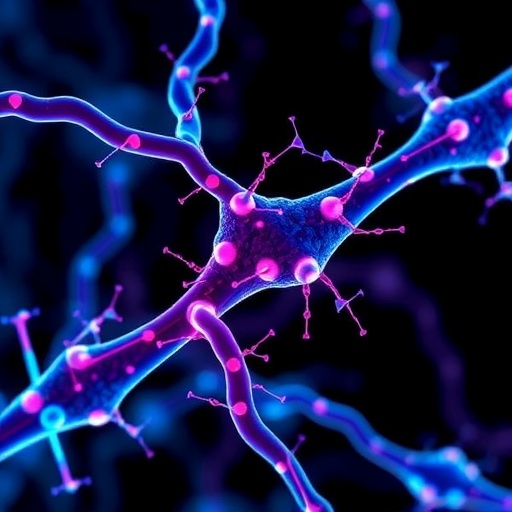In a groundbreaking study, researchers have uncovered critical insights into the complex interactions between axon regeneration genes and immune infiltration in spinal cord injuries. This exploration is particularly significant as spinal cord injuries often lead to devastating and lifelong consequences, including paralysis and loss of sensation. A deeper understanding of the underlying biological mechanisms guiding nerve regeneration and the immune response presents new avenues for therapeutic interventions aimed at enhancing recovery in patients suffering from these injuries.
The interdisciplinary team led by Xiang, Fang, and Gao published their findings in the prestigious journal, Journal of Translational Medicine. Their work provides a thorough overview of the interplay between genetic factors influencing axon regeneration and the role of immune cells infiltrating the injury site. The intricate dynamics at play not only highlight the necessity of immune response in the healing process but also unveil the potential obstacles to successful nerve regeneration.
Historically, the field of spinal cord injury research has faced significant challenges, primarily due to the complexity of the central nervous system and its unique environment. Unlike peripheral nerves, which can regenerate following injury, the central nervous system has a limited capacity for repair. This study brushes upon the innate nature of these differences, delving into the genetic and immunological landscape that serves as a battleground for regeneration and repair.
One major area of focus in the study is the identification of axon regeneration genes. These genes are crucial for the regeneration process as they encode proteins that facilitate nerve outgrowth and functional recovery. The researchers employed advanced genomic techniques to analyze the expression of these genes in various models of spinal cord injury. By comparing successful and unsuccessful regeneration instances, they were able to pinpoint specific genes integral to the regenerative process.
The second critical component covered in the research is the role of the immune system in spinal cord injuries. As part of the body’s response to trauma, immune cells infiltrating the injury site can exert both beneficial and detrimental effects. On one hand, they can promote healing and repair; on the other, an exaggerated immune response can lead to further damage and scarring, thereby impeding recovery. It is this duality that the authors aim to elucidate, providing clarity on how immune responses can be modulated to favor recovery over harm.
This study also delves into cytokines and chemokines—the signaling molecules that mediate communication between immune cells and other cell types. These molecular mediators not only dictate the nature and outcome of the immune response but also influence the activity of axon regeneration genes. Understanding how these elements interact could provide a blueprint for developing targeted therapies designed to manipulate this process to enhance recovery after spinal cord injuries.
Furthermore, the authors presented compelling evidence suggesting that specific immune cell types, such as macrophages, play a pivotal role in either supporting or hindering axon regeneration. By classifying macrophage populations into pro-inflammatory and anti-inflammatory phenotypes, they brought to light the contrasting roles these cells can exhibit during the healing process. This granularity in understanding could ultimately lead to strategic pharmacological interventions that rebalance the immune response, skewing it toward a more favorable regenerative outcome.
Notably, the researchers didn’t just stop at biological insights. They undertook a rigorous analysis of potential therapeutic avenues that could stem from their findings. One of the therapies discussed involves the use of immunomodulating agents that specifically target the inflammatory response in spinal cord injuries. By harnessing these agents in conjunction with regeneration-promoting strategies, there exists a possibility of creating a comprehensive multi-modal treatment approach that could significantly enhance recovery prospects.
In addition, the authors advocate for further research aimed at bridging the gap between basic science and clinical applications. They emphasize the importance of transitioning laboratory discoveries into clinical trials that could assess the efficacy of proposed therapies. Through partnerships with clinical researchers and institutions, the groundwork laid in this study can propel the development of novel treatment protocols that could impact the lives of countless individuals facing the consequences of spinal cord injuries.
Moreover, the study draws attention to the ethical considerations that accompany research in spinal cord injury therapies. With the potential to radically change care standards, researchers emphasize the necessity for rigorous ethical scrutiny and patient consent processes, ensuring that all treatments derived from their research are safe and equitable for patients.
As we transition into a new era of spinal cord injury treatment, the implications of these findings extend beyond individual patient care; they shape the landscape of regenerative medicine and neurobiology. Infectiously passionate, the team behind this research envisions a future where the devastation of spinal cord injuries might be mitigated through scientific innovation and interdisciplinary collaboration.
In conclusion, the insights presented by Xiang, Fang, and Gao in their recent study open a vital dialogue about the intersection of genetics, immunology, and regenerative medicine. Their research not only identifies key factors involved in the healing process but also provides essential foundations for developing clinical interventions that may one day transform the treatment of spinal cord injuries. As we stand on the precipice of potential breakthroughs, the scientific community must rally to further investigate these pathways, creating a nexus of hope for those affected by spinal cord injuries.
Subject of Research: The interplay between axon regeneration genes and immune infiltration in spinal cord injuries.
Article Title: Interplay of axon regeneration genes and immune infiltration in spinal cord injury.
Article References: Xiang, Z., Fang, D., Gao, D. et al. Interplay of axon regeneration genes and immune infiltration in spinal cord injury. J Transl Med 23, 1034 (2025). https://doi.org/10.1186/s12967-025-06915-3
Image Credits: AI Generated
DOI:
Keywords: axon regeneration, spinal cord injury, immune infiltration, cytokines, macrophages, regenerative medicine.
Tags: axon regeneration genesbiological mechanisms of nerve healingchallenges in central nervous system recoverygenetic factors in nerve repairimmune cell infiltration in injuriesimmune response in spinal cord injuryinterdisciplinary research in spinal injuriesJournal of Translational Medicine findingsnerve injury recovery obstaclesspinal cord injury rehabilitationspinal cord injury research advancementstherapeutic interventions for nerve regeneration





